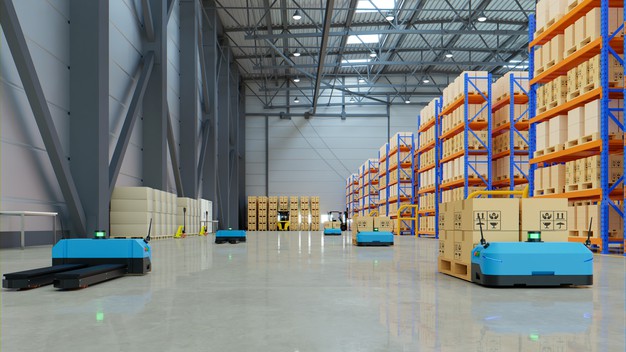
To be an effective warehouse manager, you need to know how to get products to flow through your warehouse. However, the real challenge is improving the product flow in your warehouse operations. By following these warehouse management guidelines for circulating products, minimizing handling, and maximizing utilization, you can see an improved product flow, which will be better for your company’s bottom line.
Also, there are six fundamental warehouse processes that comprise receiving, putaway, storage, picking, packing, and shipping. Optimizing these six processes will allow you to streamline your warehouse operation, reduce cost & errors, and achieve a higher perfect order rate.
Circulate Products
The best way to improve product flow is to get products into and out of your warehouse as quickly as possible. Ideally, you should ensure that the product arrives at the warehouse shortly before shipment or consumption and that the product gets shipped or sold before payment to your vendor is due. To do this, negotiate payment terms with your vendor that exceed those of your customer, turn your inventory quickly, eliminate processing errors, and make sure you ship your goods on time. All of these product circulation practices should improve your product flow and your operational cash flow.
Minimize Handling
Minimizing product handling reduces labour cost and product loss, eliminates delays, and improves quality. To manage and minimize the handling of products, you need to deploy the right quantity of product, when and where it is needed. A key factor to this is properly labelling, with clear information on what the product is, how many units there are, and what the cross-docking destination is if it has one. As a general rule, you should strive to only order quantities of product needed for short-term and immediate use. That way, you won’t have extra product lying around your warehouse, “just in case.” By minimizing product handling in these ways, you can create workflow efficiencies and improve your product flow.
Maximize Utilization
To improve your warehouse product flow, you also need to optimally manage the use of all of your resources, particularly warehouse space, transportation, and labour. Maximize your space utilization by slotting products based on physical characteristics, velocity, and relationships to other products. Coordinate the use of your transportation equipment on inbound and outbound movements, as well as carrying capacity. To amplify your labour utilization, use multitasking where possible and interweave put-away and replenishment tactics. Use these utilization strategies, and you should see improvements to your warehouse product flow.
Of course, these supply chain management guidelines are principles that should be followed generally. As a warehouse manager, you will most effectively improve your product flow by testing these tactics and tweaking them according to your individual warehouse needs. You may need warehouse management software to help you in these endeavours. Use contractERP’s mobile warehousing to improve your warehouse and your product flow.

FUNDAMENTALS OF WAREHOUSE PROCESSES
The six fundamental warehouse processes comprise receiving, putaway, storage, picking, packing, and shipping. Optimizing these six processes will allow you to streamline your warehouse operation, reduce cost & errors, and achieve a higher perfect order rate.
Receiving is the first warehouse process and one of the most crucial. To perform the receiving process properly, the warehouse should be able to verify that it has received the right product, in the right quantity, in the right condition, and at the right time. Failing to do so will have consequent impacts on all subsequent operations
Receiving also involves the transfer of responsibility for the goods to the warehouse. This places accountability on the warehouse for maintaining the condition of the goods until they are shipped. Properly receiving cargo will allow you to filter out damaged goods and avoid liability for them.
2. Put-Away
Put-away is the second warehouse process and is the movement of goods from the receiving dock to the most optimal warehouse storage location. Failing to place goods in their most ideal location can impair the productivity of warehouse operations. When goods are put away properly, there are several benefits:
- Cargo is stored faster and more efficiently
- Travel time is minimized
- Safety of goods and employees is ensured
- Warehouse space utilization is maximized
- Cargo is easier and faster to find, track, and retrieve.

3. Storage
Storage is the warehouse process in which goods are placed into their most appropriate storage space. When done properly, the storage process fully maximizes the available space in your warehouse and increases labour efficiency.
4. Picking
Picking is the warehouse process that collects products in a warehouse to fulfil customer orders. Since it is the costliest process in the warehouse, comprising as much as 55% of the total operating expense, optimizing this process will allow you to reduce costs significantly and increase your warehouse efficiency. Streamlining of this process should also focus on achieving higher accuracy, as errors can have a direct impact on your customer satisfaction.
5. Packing
Packing is the warehouse process that consolidates picked items in a sales order and prepares them for shipment to the customer. One of the primary tasks of packing is to ensure that damages are minimized from the time items leave the warehouse. Additionally, packaging must be light enough so as not to increase the weight of the goods and minimal enough to control packaging costs.

6. Shipping
Shipping is the final warehouse process and the start of the journey of goods from the warehouse to the customer. Shipping is considered successful only if the right order is sorted and loaded, is dispatched to the right customer, travels through the right transit mode, and is delivered safely and on time.
Previous processes, such as ordering, putaway, picking, and packing, are also vital to the success of shipping because they greatly affect whether the order is fulfilled accurately and safely.
The warehouse industry is growing in response to developments such as the rise of e-commerce, globalization, and the trend of outsourcing warehouse services. These major changes in the market are opportunities waiting for you to exploit by taking swift actions to optimize your warehouse processes with warehouse management software. Hopefully, this article has helped you understand the objective of each process and helped in providing tips for optimization.
 Start using ZapInventory today
Start using ZapInventory today
